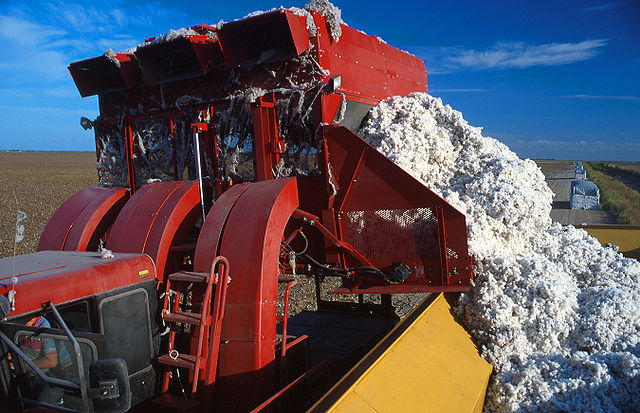
Washington FDA Says, ‘Let Them Eat Cotton’
By F. William Engdahl
29 October 2019
Image credits: This image is in the public domain because it contains materials that originally came from the Agricultural Research Service, the research agency of the United States Department of Agriculture https://bit.ly/2WqY1HU
US Government regulators have approved a genetically modified cotton variety as a “potential solution to human hunger.” The radical decision is to permit consumption by humans, in addition to animals, of seeds of a GMO cotton developed at Texas A&M University, with no independent long-term testing. It opens grave new concerns about the safety of our food chain. Soon, as a result, the world food chain may well be contaminated with the GMO cottonseeds whose dangers have been simply ignored by authorities
.
The USA Food and Drug Administration (FDA) has just approved a new type of GMO cotton for unregulated release. The type, called TAM66274, has been genetically modified supposedly to make the seeds fit for human or animal feed by suppressing the presence of a dangerous toxin in the seed, while allegedly leaving the toxin only in the rest of the cotton plant.
With FDA approval the GMO cottons seeds will now be allowed as food for people or animals. The project has been led by Keerti Rathore, a plant biotechnology protégé of the late Norman Borlaug, at the Texas A&M AgriLife Research Center.
Rathore says the group will now seek approval in other countries starting with Mexico. He calculates that, “There are approximately 10.8 trillion grams of protein locked up in the annual global output of cottonseed. This is enough to meet the basic protein requirements of over 500 million people at a rate of 50 grams of protein per person per day.” He says the GMO cottonseeds can also be used to feed pigs, poultry or farmed fish or shrimp. His group sees it as a major new source of protein for consumption, as well as profit for cotton growers. It is not surprising that Cotton Inc., the US cotton lobby group is sponsoring the GMO project.
Cotton Inc. and Monsanto have a history of cooperation as well. Rathore says for every pound of cotton fiber, the plant produces about 1.6 pounds of seed. The annual global cottonseed production equals about 48.5 million tons. If that can now be turned into cottonseed oil or meal for human and animal consumption and sold, it adds a huge profit boost to cotton producers. The world’s largest purveyor of cotton seeds for planting cotton is Monsanto, now part of Bayer AG.
“The kernels from the safe seed could be ground into a flour-like powder after oil extraction and used as a protein additive in food preparations or perhaps roasted and seasoned as a nutritious snack,” Rathore said.
On October 1 the FDA released its summary of findings for the Texas application which had been made in 2017. That gives the impression the Government researchers were making an intensive testing of the highly controversial issue of whether to permit human consumption of the GMO cotton seeds or not. Far from the case. As the FDA states in their findings of October, 2019, the FDA declaration was simply copied from the tests given them by the producer, Texas A&M and its biotech research group, funded by the US cotton industry group, Cotton Inc.
Highly toxic gossypol
The FDA approval, made with no apparent independent testing of the results given them by the group at the A&M AgriLife Research center, is notable given the fact that cottonseeds contain a highly toxic substance in the seeds known as gossypol. Because of gossypol, previously much of the weight of cotton plants was wasted or usable only for limited animal feed only after special treatment. The seeds were deemed unsuitable for human consumption.
The A&M GMO cotton was modified using what is called RNA interference technology, RNAi, to “silence” a gene that supposedly, again according to its developers, “greatly” reduces gossypol from the cottonseed. Rathore claims to have suppressed the gene of a cotton plant to produce cotton with gossypol in everything but its seeds: “We have eliminated this gossypol from the seed without affecting its levels in other parts of the plant,” said Rathore. “With the toxin removed from the cottonseed, it can potentially feed 500 to 600 million people per year.” Well, almost eliminated it, to be more accurate. They admit that about 3% gossypol remains in the seeds.
Now we are entitled to eat the “low” gossypol seeds which are said to be protein rich and supposedly safe. There are several alarming aspects to this FDA decision to release the GMO cotton variety for human and animal consumption.
Not Adequately Tested For Safety
First of all, as researcher Claire Robinson points out in an excellent analysis, the RNAi procedure for cotton is hardly proven to be safe. She notes scientific research that shows risks of GMO RNAi crops. One study found that RNAi molecules in food plants can survive digestion and enter the body of the human or animal eating it, and even affect the gene expression of the human or animal with unpredictable side effects. Robinson stresses that the FDA made no adequate thorough tests for safety of the GMO cotton, nor did Texas researchers. She notes, “No toxicity testing in animals has been done on the seeds that are intended for consumption. The application only refers to testing in mice of the NPTII antibiotic resistance gene product, though it does not mention how long the tests lasted.”
Not only are the range of tests submitted by the Rathore group deficient or inadequate, they admit that their GMO variety has not entirely eliminated the presence of toxic gossypol in the cottonseeds, hence they term it “low” gossypol cotton seed, with an estimated 3% gossypol. Absent are any tests long-term on mice or other animals of effects of 3% or low gossypol GMO cottonseeds.
Population Reduction?
Gossypol among other traits is a human contraceptive. A study published in the journal Contraception notes that gossypol, “in most animals, provokes infertility, and in man it causes spermatogenesis arrest at relatively low doses… Gossypol should be prescribed preferably to men…who would accept permanent infertility after a few years of use.” It seems to be irreversible for many.
Another study published in The Scientific World Journal notes that among other toxic effects, “…free gossypol may be responsible for… respiratory distress, impaired body weight gain, anorexia, weakness, apathy, and death after several days. However, the most common toxic effect is the impairment of male and female reproduction. Another important toxic effect of gossypol is its interference with immune function, reducing an animal’s resistance to infections…”
Now according to the FDA, we humans are animals too for purposes of consuming GMO cottonseeds. Is a presence of 3% gossypol in now “edible” GMO cottonseeds enough to cause stealth contraception in humans, or any of the other grave symptoms? We simply don’t know as none of the responsible US regulators, neither at USDA nor FDA, have apparently bothered to seriously test.
What has the FDA done to safeguard the health and safety of potential human or animal consumers of the GMO cotton? A careful reading of the FDA testing summary of October 1 shows the entirety of their evaluation, as noted, is lifted directly from the test results given them by Rathore’s group at Texas A&M. And Rathore omits details of the length of their testing, which can conceal negative effects that only show up after longer time tests. Other tests are superficial and inconclusive.
Speaking of his hopes for the application of his new GMO cotton type, Rathore declares, “My personal preference as we move forward would be to follow the ‘Golden Rice’ example in terms of its use for humanitarian purposes.” The only problem with that example is that the Philippines project financed by the Rockefeller Foundation in the 1990s to develop Golden Rice, supposedly high in Vitamin A, was a colossal failure that was later abandoned by its creators. It was simply used as a GMO PR stunt. It could well be that the inadequately tested GMO cottonseeds end up blended into our food like so many such ingredients with us being none the wiser. The precautionary principle seems to have been shredded by scientists at FDA.
F. William Engdahl is strategic risk consultant and lecturer, he holds a degree in politics from Princeton University and is a best-selling author on oil and geopolitics, exclusively for the online magazine “New Eastern Outlook”
